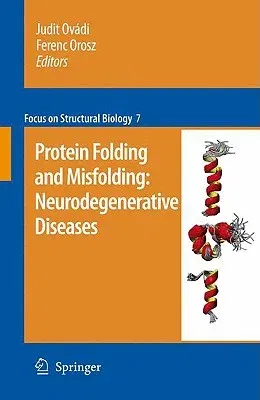1. Structural Disorder and Its Connection with Misfolding Diseases;
Veronika Csizmok and Peter Tompa. 1.1 The Concept of Protein Disorder.
1.2 Biophysical and Bioinformatics Characterization of Disorder. 1.2.1
Biophysical Techniques 1.2.2 Bioinformatics Techniques. 1.3 Disorder in
Vivo, the Effect of Crowding? 1.4 Disorder and Aggregation. 1.5 Disorder
in Neurodegenerative Diseases. 1.6 Physiological Prions. 1.7 Structural
Transition to Amyloid: Partially Folded Intermediates. 1.8 The Structure
of Amyloid: Cross-Beta Models and Flexibility. 1.9 Conclusions.
References. 2 Intrinsic Disorder in Proteins Associated with
Neurodegenerative Diseases Vladimir N. Uversky. 2.1 Neurodegenerative
Diseases as Proteinopathies. 2.2 Introducing Intrinsically Disordered
Proteins. 2.2.1 Concept. 2.2.2 Experimental Techniques for IDP
Detection. 2.2.3 Sequence Peculiarities of IDPs and Predictors of
Intrinsic Disorder. 2.2.4 Abundance of IDPs and their Functions.
2.3Abundance of IDPs in Neurodegenerative Diseases. Evidence from the
Bioinformatics Analyses. 2.4 Intrinsic Disorder in Proteins Associated
with -Protein and Alzheimer's Disease. 2.4.2 Neurodegenerative Diseases.
2.4.1 Amyloid Tau Protein in Alzheimer's Disease and Other Tauopathies.
2.4.3 Prion Protein and Prion Diseases. 2.4.4 Synucleins - and Synuclein
and Synucleinopathies. 2.4.5 Parkinson's Disease and Dementia with Lewy
Bodies. 2.4.6 Polyglutamine Repeat Diseases and Huntingtin, Ataxin-1,
Ataxin-3, androgen Receptor and Atrophin-1. 2.4.7 Abri Peptide and
Familial British Dementia. 2.4.8 Adan in Familial Danish Dementia. 2.4.9
Glial Fibrillary Acidic Protein and Alexander and Alpers Disease.
2.4.11DNA Disease. 2.4.10 Mitochondrial DNA Polymerase Excision Repair
Protein ERCC-6 and Cockayne Syndrome. 2.4.12 Survival of Motor Neurons
Protein and Spinal Muscular Atrophy. 2.5 Concluding Remarks: Another
Illustration of the D2 Concept. References. 3 Dynamic Role of
Ubiquitination in the Management of Misfolded Proteins Associated with
Neurodegenerative Diseases. Esther S.P. Wong, Jeanne M.M. Tan and
Kah-Leong Lim. 3.1 Protein Misfolding and the Ubiquitin-Proteasome
System. 3.2 Protein Misfolding, UPS Disruption and Neurodegeneration.
3.3 Diversity of Ubiquitin Modifications. 3.4 Non-Proteolytic
Ubiquitination and Protein Inclusions Biogenesis. 3.5 Aggresomes
Formation and Clearance. 3.6 K63-Linked Polyubiquitination - A Novel
Cargo Recognition Signal For Autophagic Degradation. 3.7 A Model of
Inclusion Biogenesis and Clearance. 3.8 E2/E3 Pairs - Triage officers?.
3.9 Conclusions. References. 4. Protein Misfolding and Axonal Protection
in Neurodegenerative Diseases. Haruhisa Inoue, Takayuki Kondo and
Ryosuke Takahashi. 4.1 Neuronal Dysfunction in Neurodegeneration Are
Reversible Process. 4.2 Neuronal Dysfunction Is Not Treatable by
Anti-Cell Death Therapy. 4.3 Morphological Aspects of Neuronal
Dysfunction Caused by Protein Aggregation/Misfolding in Human
Neurodegenerative Disorder. 4.4 Protein Misfolding and Axonal
Degeneration in Experimental Animal Models. 4.5 Therapeutic approaches
to treat neuronal dysfunction by axonal protection. 4.5.1 Axonal
regeneration. 4.5.2 Anti-Wallerian Degeneration. 4.5.3 Autophagy
Enhancement. 4.5.4 Stabilization of Microtubules. 4.6 Concluding
remarks. References. 5. Endoplasmic Reticulum Stress in
Neurodegeneration Jeroen J.M. Hoozemans and Wiep Scheper.
5.1Introduction. 5.2 Protein Quality Control in the Endoplasmic
Reticulum. 5.2.2 Triage: ERAD. 5.2.3 Degradation: Ubiquitin Proteasome
System and Autophagy. 5.2.4 Stress Response: The Unfolded Protein
Response. 5.2.5 ER-Stress-Induced Cell Death. 5.3. ER Stress in
Neurodegenerative Disorders. 5.3.1 Alzheimer's Disease. 5.3.2
Parkinson's Disease 5.3.3 Prion Disease. 5.3.4 Tauopathies. 5.3.5
Polyglutamine Diseases. 5.3.6 Amyotrophic Lateral Sclerosis. 5.3.7 White
Matter Disorders. 5.4 Conclusions .References. 6. Involvement of Alpha-2
Domain in Prion Protein Conformationally-Induced Diseases Luisa

